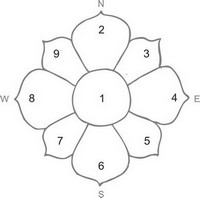|
The Oral Transmission on the Significance Ongi Kuden,
The first day of the first month of the first year of Kō,an [1278], at 57 years of age Nam Myōhō Renge Kyō The Oral Transmission on the Meaning of the Dharma Flower Sutra (Ongi Kuden) states that Namu is a word that comes from Sanskrit (Namas); here, when rendered into Chinese, it means “upon what we devote and establish our lives”. The Object of Veneration (gohonzon), whereupon we establish our lives and to which we devote them, is both the person of Nichiren and the Dharma, which is characterised by the one instant of thought containing three thousand existential spaces. The person is the Eternal Shākyamuni who is contained within the text of the Sutra on the White Lotus Flower-like Mechanism of the Utterness of the Dharma (Myōhō Renge Kyō). The Dharma is the Sutra on the White Lotus Flower-like Mechanism of the Utterness of the Dharma (Myōhō Renge Kyō) as the recitation of its title and subject matter [the daimoku which is Nam Myōhō Renge Kyō] and its Fundamental Object of Veneration (gohonzon), to both of which we dedicate and establish our lives on. Again, devotion means to turn to the principle of the eternally unchanging, indispensable quality of existence (fuhen shinnyo) [the fixed principle of the true nature of existence], as it was expounded in the teachings derived from the external events of Shākyamuni’s life and work (shakumon). The establishment of one’s life means that it is founded on the wisdom of the original archetypal state (honmon), which is reality as it changes according to karmic circumstances (zuien shinnyo). We in fact establish our lives on and devote them to Nam Myōhō Renge Kyō, which means to devote our lives to and found them on (Nam[u]) the Utterness of the Dharma [entirety of existence, enlightenment and unenlightenment] (Myōhō) permeated by the underlying white lotus flower-like mechanism of the interdependence of cause, concomitancy and effect (Renge) in its whereabouts of the ten [psychological] realms of dharmas (Kyō). There is an explanation by the Universal Teacher Dengyō (Dengyō Daishi) who states, “. . . . both the wisdom of the teachings of the original archetypal state (honmon), which implies reality as it changes according to karmic circumstances (zuien shinnyo), and the principle of the eternally unchanging, indespensable quality of existence at the same time (fuhen shinnyo) [the fixed principle of the true nature of existence], as it was expounded in the teachings derived from the external events of Shākyamuni’s life and work (shakumon) . . . . .” This refers to the silence and the shining light that are in fact the real and fundamental nature of life itself. Also, devotion is the manifestation of our physical selves, whereas establishing our lives on something is a dharma of the mind. The ultimate teaching of the Sutra on the White Lotus Flower-like Mechanism of the Utterness of the Dharma (Myōhō Renge Kyō) points out that both mind and materiality are not separate from each other. There is an explanation that says, “We take refuge in this ultimate teaching [i.e., the Dharma Flower Sutra (Hokke-kyō)], because it is the vehicle to enlightenment that the Buddha himself relied on.” The Oral Transmission on the Meaning of the Dharma Flower Sutra (Ongi Kuden) then goes on to say that the Nam(u) of Nam Myōhō Renge Kyō is derived from Sanskrit (Namas) and that myōhō, renge, and kyō are words of Chinese origin. This makes Nam(u) Myōhō Renge Kyō both Sanskrit and Chinese at the same time. [At the time of Nichiren these two languages were the main tongues of humankind.] Also Myōhō Renge Kyō is in Sanskrit Saddharma Pundarîka Sutram. Sad [the phonetic change of Sat] is Utterness in English and Myō in Japanese. The nine ideograms that are a substitute for the Sanskrit lettering are the five Buddhas and four bodhisattva entities on the eight petals and the centre of the lotus flower that lies in the breast of all sentient beings. [This eight-petalled lotus with the five Buddhas (one in the centre) and four bodhisattva entities is a Shingon or Tantric concept that is the central court of the mandala that represents the underlying Buddha nature that runs through the whole of both physical and mental existence.] This concept implies that the nine realms of dharmas of ordinary existence are not separate from the oneness of the enlightened realm of the Buddha. Myō or Utterness is the Dharma realm or enlightenment, which is Nam Myōhō Renge Kyō and all its implications. Hō or dharmas stands for unclearness and unenlightenment. So, when unclearness and enlightenment become a single entity, it is called the Utterness of the Dharma (Myōhō, Saddharma). The lotus flower (Renge) stands for the two dharmas of cause, concomitancy and effect. This is the interdependence of cause, concomitancy and effect. Kyō or sutra is the expression of the words, speech, voices, and sounds of all sentient beings. This is explained as when the voice is in the service of the Buddha enlightenment; then this is what is called a sutra. A sutra may also be described as that which is constant and unchanging throughout the past, present, and future. The Dharma realm of the Buddha or all the realms of dharmas of ordinary people are the Utterness of the Dharma (Myōhō, Saddharma). The Dharma realm or the realms of dharmas of ordinary people is the location where they occur (Kyō). The eight-petalled lotus with the five Buddhas and four bodhisattvas is the substantiation of the Buddha enlightenment in all of us. You should think this over thoroughly.
The Eight-petalled Lotus with the Five Buddhas and the Four Bodhisattvas The eight-petalled lotus shows the five Buddhas and four bodhisattvas [one Buddha in the centre and four others in the cardinal directions], the other four quarter points being occupied by bodhisattvas. This is the same as the mandala of the womb treasury (taizōkai, garbhadātu) that is used by the Tantric and Mantra School (Shingon) in Japan. The womb treasury (taizōkai, garbhadātu) is the fundamental source of enlightenment, as well as life itself. This matrix is comparable to a womb in which a child is conceived. This matrix is comparable to a womb in which a child is conceived. It is both the container and its contents which entail the fundamental of enlightenment and wisdom in its purest state. It also represents the human heart (mind) in its essential innocence and purity, which is seen as the compassion of the Buddha and his moral awareness. The central Buddha of this mandala, is the Tathāgata of the Universal Sun (Dainichi-Nyorai, Mahavairochana-Tāthagata), who emanates his light onto all the other manifestations of wisdom and enlightenment. It is the enlightenment of the original archetypal state (honmon), which induced the teachings of Shākyamuni that were derived from the external events of his life and work (shakumon). On the eastern petal is the Buddha Jeweled Banner (Hōtō, Ratnaketa); on the southern petal sits the Buddha Sovereign of the Flowering of the Whole Surface [to be enlightened] (Kaifuka’ō). On the western petal is the Buddha of Boundless Light (Amitābha Buddha, Amida Butsu), and on the northern petal sits the Buddha who represents the Dharma-kāya or the universal entity of the Buddha (Tenkurai’on, Amoghasiddhi). The remaining petals represent the four bodhisattvas. On the southeastern petal is the Bodhisattva Universally Worthy (Fugen, Samantabhadra); on the northeastern petal sits the Bodhisattva Perceiving the Sounds of the Existential Dimensions (Kanzeon, Avalokiteshvara); on the northwestern petal is the Bodhisattva Maitreya (Miroku); and on the southwestern petal sits the Bodhisattva Mañjushrī (Monjushiri). All these Buddhas and bodhisattvas are seen as the nine honoured ones. Also, the lotus flower in this context is thought of as a symbol for the heart or mind of sentient beings. In The Oral Transmission of the Meaning of the Dharma Flower Sutra (Ongi Kuden), the nine honoured ones are understood as the principle of the nine realms of dharmas not being separate from the Dharma realm of the Buddha. They are the following: 
1. The Tathāgata of the Universal Sun (Dainichi-Nyorai, Mahavairochana-Tāthagata)
 A view of the Bugaboo Mountains (Purcell mountain range) along the Columbia River Valley at Brisco, BC
Martin Bradley, The Buddha Writings of Nichiren Daishōnin, ISBN: 2-913122-19-1, 2005,
 The Buddha Writings of Nichiren Daishōnin by Martin Bradley The Buddha Writings of Nichiren Daishōnin by Martin Bradley is licensed under a Creative Commons Attribution-Noncommercial-No Derivative Works 2.5 Canada License. |
|
